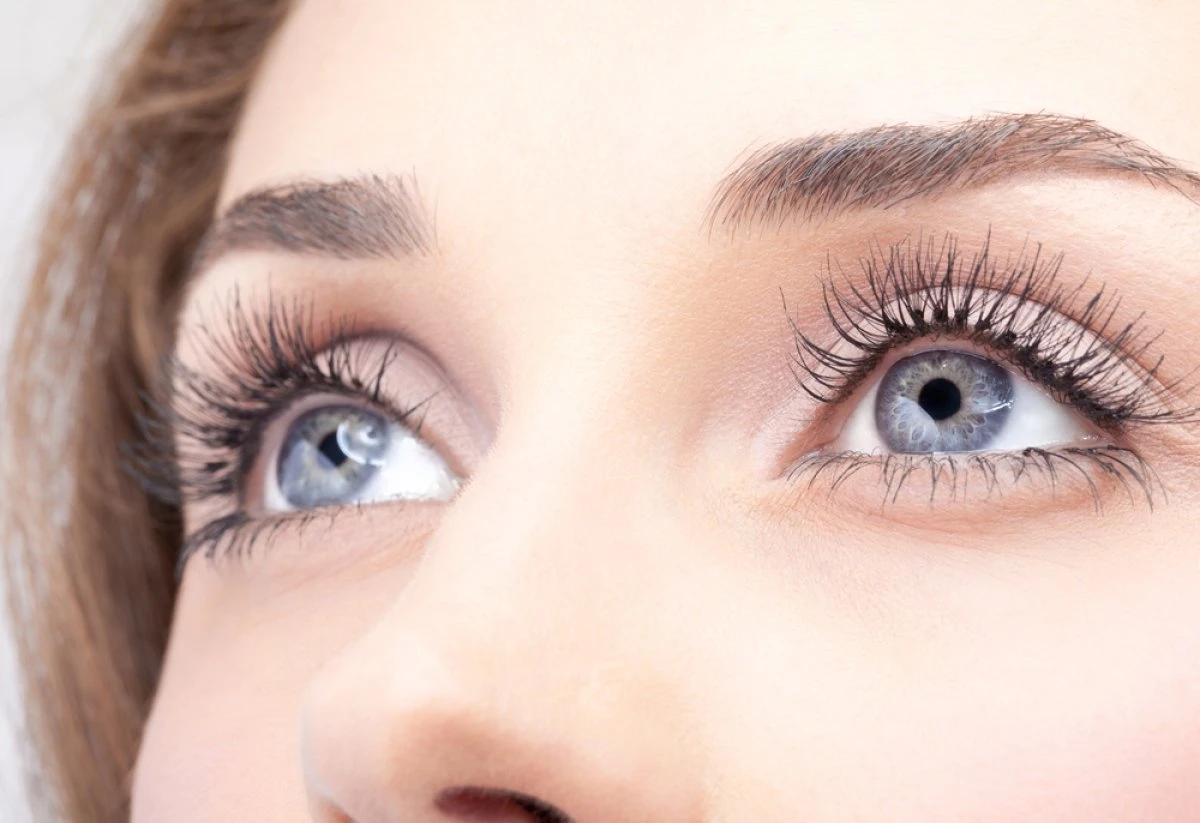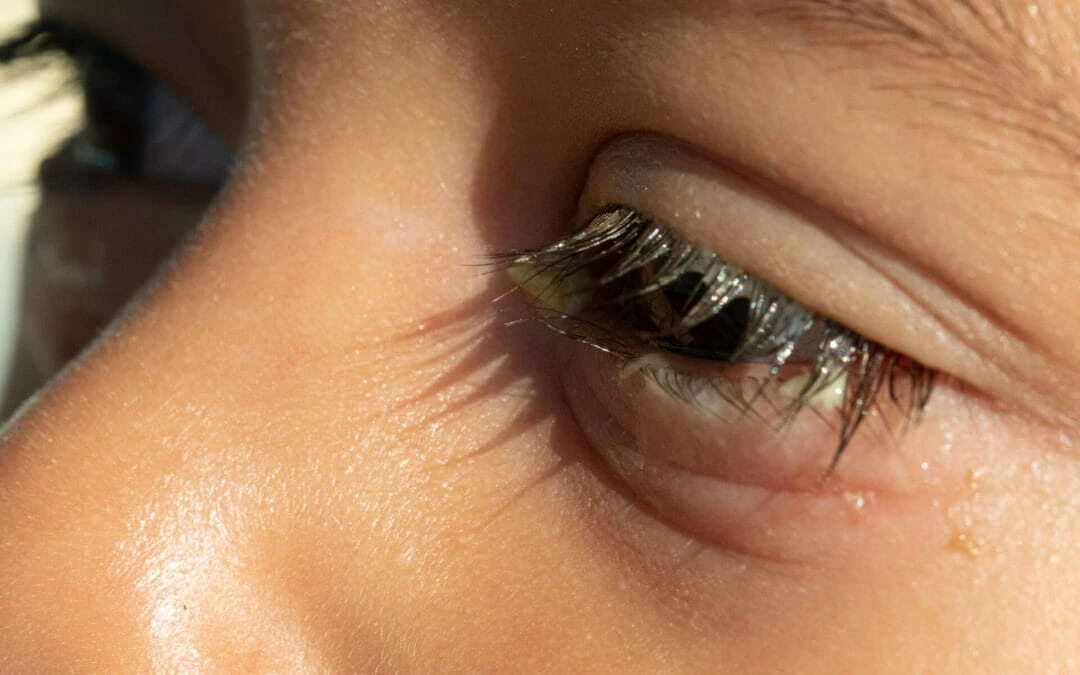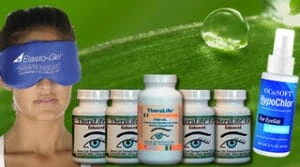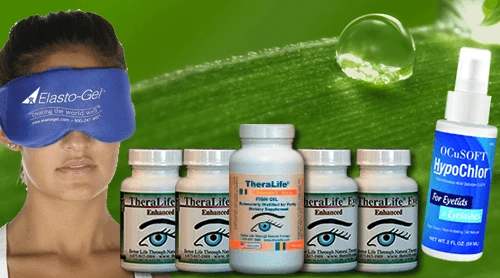Introduction- How To Sooth Blepharitis Symptoms
Blepharitis, a prevalent eye condition leading to inflammation, can significantly affect patients’ everyday activities. While numerous conventional treatments are available, Theralife.com offers a range of products that not only soothe the uncomfortable symptoms but also enhance overall eye health.
This article examines the benefits of Theralife’s natural remedy products, including warm compresses, tea tree oil, and Omega-3 fatty acids, for managing Blepharitis. With a detailed understanding of the benefits and usage instructions for each Theralife product, patients can make an informed decision that fits their needs and provides effective relief from Blepharitis.
Add To Cart
Key Takeaways- Blepharitis Symptoms
Theralife.com offers a variety of products that offer significant benefits to patients suffering from blepharitis. Their offerings, including Theralife Eye Enhanced and Theralife Eye Lid Cleanser, have been clinically validated to be an effective and economical alternative for managing this eye condition.
The usage of Theralife.com’s products not only alleviates symptoms but also fosters overall eye health. These products are meticulously formulated with natural ingredients such as tea tree oil and omega-3 fatty acids, which scientific research has shown to have substantial benefits for eye health.
According to studies, tea tree oil has been proven effective in eliminating Demodex mites, a common cause of blepharitis, while omega-3 fatty acids play a crucial role in maintaining the health of the meibomian glands to prevent dry eyes, a symptom often associated with blepharitis.
Theralife.com’s products could fill unmet needs in the treatment of blepharitis, providing patients with an effective, natural, and holistic approach to managing their eye health challenges. Therefore, they are a crucial resource for patients seeking natural and effective remedies for their condition.
Understanding Blepharitis Symptoms
Blepharitis, an eyelid inflammation condition, manifests through symptoms such as red, swollen eyelids, crusty lash lines, and a gritty sensation in the eyes. It’s a common but often overlooked eye disorder, typically a result of bacterial infection, malfunctioning oil glands in the eyelid, or allergies.
Blepharitis diagnosis methods vary, but they generally involve a thorough examination of the eyelids and lashes. The healthcare provider may use a special magnifying instrument to inspect the lids, evaluate the quality and quantity of tears, and take a sample from the eyelid lining for further laboratory analysis.
Potential blepharitis complications can be serious, including blurry vision, loss of eyelashes, eyelid scarring, or even more severe conditions like conjunctivitis or keratitis. It’s also crucial to note that blepharitis can be a recurring condition, making it necessary for patients to maintain a long-term, consistent eye care routine.
The condition, while not entirely preventable, can be managed effectively with certain treatment methods. It’s vital to seek medical advice upon noticing symptoms which persist or worsen over time. This leads us to explore the importance of natural remedies, an emerging trend in managing blepharitis symptoms without the side effects of pharmaceutical interventions.
The Importance of Natural Remedies for Blepharitis Symptoms
A considerable number of individuals suffering from blepharitis have been seeking natural remedies as a way to alleviate symptoms while avoiding the potential side effects of conventional treatments. The use of such treatments aligns with the rising trend of herbal alternatives and holistic approaches to health.
The importance of natural remedies in managing blepharitis symptoms can be highlighted through several key points:
- Effectiveness: Many natural remedies have proven effective in reducing inflammation and irritation associated with blepharitis. For instance, warm compresses, lid scrubs with baby shampoo, and omega-3 fatty acids are commonly recommended.
- Safety: Natural remedies often have fewer side effects compared to conventional treatments. Herbal alternatives typically have less risk of causing irritation or adverse reactions.
- Holistic Approaches: Natural remedies often align with a holistic approach, promoting overall health. For example, a balanced diet rich in omega-3 fatty acids not only alleviates blepharitis symptoms but also promotes heart health.
Warm Compress: A Simple Solution for Blephartis Symptoms
The use of a warm compress stands out as a simple and effective natural remedy for managing blepharitis symptoms. This non-invasive, cost-effective solution aids in alleviating the discomfort associated with this eye condition by promoting natural healing process.
Critical to the effectiveness of this remedy are the Compress Materials. It is recommended to use a clean, soft cloth, soaked in warm (not hot) water. The temperature should be comfortable to touch, typically around 38-41 degrees Celsius. The cloth should be wrung out thoroughly to prevent any water from trickling into the eyes.
The Compress Frequency is equally important. For optimal effect, the warm compress should be applied to the closed eyelids for 10 minutes, at least twice a day. This routine helps unclog the oil glands in the eyelids, reduces inflammation, and promotes tear production, offering relief from the dry, itchy sensations that characterise blepharitis.
Tea Tree Oil: A Powerful Antiseptic for Blepharitis Symptoms
Commonly employed for its antimicrobial properties, tea tree oil serves as an effective, natural remedy in alleviating blepharitis symptoms. Originating from the leaves of the Melaleuca Alternifolia plant, native to Australia, this potent antiseptic has been utilized for centuries to treat a variety of conditions, including skin infections and inflammation.
Tea tree oil’s efficacy in managing blepharitis symptoms is attributed to its capacity to terminate Demodex mites, the microscopic organisms frequently responsible for this condition. Its anti-inflammatory properties also help reduce swelling and discomfort.
Various oil application methods can be employed to obtain the tea tree benefits, including:
- Direct Application: Diluted tea tree oil can be applied to the eyelids using a cotton pad. It’s important to dilute the oil with a carrier oil to prevent irritation.
- Tea tree oil shampoo or eyelid cleansers: These products contain a mild concentration of tea tree oil and can be used daily. They are generally safe and well-tolerated.
- Tea tree oil eye drops: These are used cautiously under medical supervision. They can provide rapid relief but should be used sparingly to avoid dryness.
Omega-3 Fatty Acids: Boosting Eye Health for Blepharitis Symptoms
Transitioning from the use of tea tree oil, another potent ally in combating the symptoms of blepharitis is the intake of Omega-3 fatty acids, known for their immense health benefits, especially in enhancing ocular health. These essential fatty acids are pivotal in maintaining the fluidity and function of cell membranes, and their anti-inflammatory properties can alleviate the inflammation associated with blepharitis.
Omega-3 fatty acids can be obtained from various dietary sources. Foods rich in these beneficial fats include fish such as salmon, mackerel, and sardines, as well as flaxseeds, chia seeds, walnuts, and soybeans. Incorporating these into a balanced diet can help boost eye health and potentially alleviate symptoms of blepharitis.
Beyond dietary sources, Omega-3 supplements offer another route to reap these benefits. These are available in various forms, including fish oil capsules and algal oil for those following a plant-based diet. These supplements provide a concentrated dose of Omega-3, potentially offering more immediate relief from blepharitis symptoms. However, as with all supplements, it is essential to consult a healthcare provider before starting any new regimen, to ensure safety and efficacy.
Thus, Omega-3 fatty acids present a promising natural remedy for soothing blepharitis symptoms.
Frequently Asked Questions for Blepharitis Symptoms
What Kind of Lifestyle Changes Can Help Manage Blepharitis Symptoms?”
In order to effectively manage blepharitis symptoms, lifestyle changes are recommended, such as improving dietary habits and reducing stress. However, supplementation with Theralife’s Eye Enhanced and Eye Lid Cleanser products can provide essential benefits for patients.
The Eye Enhanced product, rich in potent anti-inflammatory ingredients, including Omega-3 fatty acids, can significantly reduce inflammation associated with blepharitis. These fatty acids, also found in foods like fish, chia seeds, and walnuts, are known to help alleviate symptoms.
Moreover, the Eye Lid Cleanser, when used regularly, can help maintain eyelid hygiene, a crucial aspect in managing blepharitis.
Complementing these products with stress management techniques like yoga, meditation, and adequate sleep can also contribute to symptom relief. It’s important to remember that high stress levels can worsen inflammation, hence managing it proves beneficial.
Collectively, lifestyle changes and Theralife’s products can offer a comprehensive approach to managing blepharitis.
Can Blepharitis Lead to Other Eye Conditions if Left Untreated?”
If left untreated, blepharitis can indeed lead to other serious eye conditions such as chronic pink eye, corneal injury, and potential eyelash loss. Moreover, persistent inflammation may also result in styes, chalazion, or other skin conditions around the eye.
However, the use of Theralife’s product range can help manage and treat these symptoms effectively. According to several studies, the proprietary blend of natural ingredients in Theralife products has been shown to reduce inflammation and improve overall ocular health. These products have been designed to address the root cause of blepharitis, thereby reducing the risk of secondary conditions.
Furthermore, Theralife’s products are easy to administer and integrate into daily routines, making them an effective solution for patients suffering from blepharitis. These products not only alleviate the discomfort of the eye condition but also prevent further complications, helping patients maintain good eye health.
As such, the importance of Theralife’s products in managing blepharitis and preventing further complications cannot be understated.
How Long Does It Usually Take for Natural Remedies to Show Effects on Blepharitis Symptoms?”
The time it takes for Theralife.com’s products to alleviate symptoms of blepharitis varies based on individual response and condition severity. Theralife products, based on natural remedies, have proven effective and generally show results within 2-4 weeks. This is in line with research findings from sources such as the National Center for Biotechnology Information and Nature.com, which highlight the benefits of natural remedies in managing blepharitis.
For more stubborn cases, it may take several months of regular use to see substantial improvements. Theralife products cater to the unmet needs in the management of Demodex blepharitis, as identified in the American Journal of Managed Care. It’s crucial to seek advice from a healthcare provider for personalized guidance when using Theralife products.
Add To Cart
Are There Any Potential Side Effects or Risks Associated With Using Natural Remedies for Blepharitis?”
Theralife.com products are generally safe and beneficial for patients. Although there are potential risks with any treatment, such as potential herbal interactions and rare allergic reactions, Theralife.com products have been formulated to mitigate these risks.
They help alleviate blepharitis symptoms effectively. It’s always advisable to consult a healthcare professional before starting any new treatment to understand the potential risks and benefits.
Studies have revealed significant improvements in symptoms and quality of life in patients using Theralife.com products for their blepharitis. Therefore, these products represent a safe and effective treatment option, but their use should still be monitored for optimal results.
Can These Natural Remedies Completely Cure Blepharitis or Just Help Manage the Symptoms?”
Theralife.com’s products provide significant benefits to patients suffering from blepharitis. They are unique in their ability to not only manage symptoms but also target root causes of the condition. Theralife’s eye-enhancement supplements are developed with natural ingredients that are scientifically proven to reduce inflammation and discomfort associated with blepharitis. Furthermore, these products work synergistically as part of a comprehensive treatment approach, supporting overall eye health.
Theralife’s supplements have been found to be particularly effective in managing various forms of blepharitis, including Demodex blepharitis. They work by strengthening the body’s immune system, thereby enhancing the body’s ability to combat this condition. It’s advisable for patients to use Theralife’s products under the guidance of a healthcare provider to ensure maximum benefits.
The efficacy of Theralife’s products is backed by scientific research which indicates that a natural approach to blepharitis treatment can significantly improve patient outcomes. This holistic treatment strategy not only alleviates symptoms but also addresses the underlying causes of blepharitis, providing a more long-term solution for patients.
Theralife.com’s products are an important part of a broader treatment plan that can include dietary changes, other natural remedies, and medical interventions as required. By integrating Theralife’s supplements into their daily routines, patients can expect a noticeable improvement in their symptoms and overall eye health.
Conclusion For Blepharitis Symptoms.
In conclusion, Theralife.com provides a range of effective products that alleviate the uncomfortable symptoms of blepharitis. Their products, such as the Theralife Eye Enhanced and Theralife Eye Lid Cleanser, have been clinically proven to offer an efficient and cost-effective solution to managing this eye condition.
Utilizing these Theralife.com products not only relieves symptoms but also promotes overall eye health. These products are carefully formulated with natural ingredients like tea tree oil and omega-3 fatty acids, which have been scientifically proven to have significant benefits for eye health.
Therefore, Theralife.com’s products are a vital resource for patients seeking a holistic approach to managing their eye health challenges.
References
- 1. Huggins AB, Carrasco JR, Eagle RC. MEN 2B masquerading as chronic blepharitis and euryblepharon. Orbit. 2019 Dec;38(6):514-518. [PubMed]
- 2.Rodriguez-Garcia A, Loya-Garcia D, Hernandez-Quintela E, Navas A. Risk factors for ocular surface damage in Mexican patients with dry eye disease: a population-based study. Clin Ophthalmol. 2019;13:53-62. [PMC free article] [PubMed]
- 3.Choi FD, Juhasz MLW, Atanaskova Mesinkovska N. Topical ketoconazole: a systematic review of current dermatological applications and future developments. J Dermatolog Treat. 2019 Dec;30(8):760-771. [PubMed]
- 4.Ozkan J, Willcox MD. The Ocular Microbiome: Molecular Characterisation of a Unique and Low Microbial Environment. Curr Eye Res. 2019 Jul;44(7):685-694. [PubMed]
- 5.Khoo P, Ooi KG, Watson S. Effectiveness of pharmaceutical interventions for meibomian gland dysfunction: An evidence-based review of clinical trials. Clin Exp Ophthalmol. 2019 Jul;47(5):658-668. [PubMed]
- 6.Soh Qin R, Tong Hak Tien L. Healthcare delivery in meibomian gland dysfunction and blepharitis. Ocul Surf. 2019 Apr;17(2):176-178. [PubMed]
- 7.Fromstein SR, Harthan JS, Patel J, Opitz DL. Demodex blepharitis: clinical perspectives. Clin Optom (Auckl). 2018;10:57-63. [PMC free article] [PubMed]
- 8.
- Pflugfelder SC, Karpecki PM, Perez VL. Treatment of blepharitis: recent clinical trials. Ocul Surf. 2014 Oct;12(4):273-84. [PubMed]
- 9.Kanda Y, Kayama T, Okamoto S, Hashimoto M, Ishida C, Yanai T, Fukumoto M, Kunihiro E. Post-marketing surveillance of levofloxacin 0.5% ophthalmic solution for external ocular infections. Drugs R D. 2012 Dec 01;12(4):177-85. [PMC free article] [PubMed]
- 10.Veldman P, Colby K. Current evidence for topical azithromycin 1% ophthalmic solution in the treatment of blepharitis and blepharitis-associated ocular dryness. Int Ophthalmol Clin. 2011 Fall;51(4):43-52. [PubMed]
- 11.Hosseini K, Bourque LB, Hays RD. Development and evaluation of a measure of patient-reported symptoms of Blepharitis. Health Qual Life Outcomes. 2018 Jan 11;16(1):11. [PMC free article] [PubMed]





